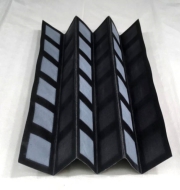Scientists build bacteria-powered battery on a paper sheet
US-based scientists have developed a bacteria-powered battery (bio-battery) on a single sheet of paper, which is capable of powering disposable electronics.
The paper-based bacteria-powered battery design is part of a new field of research called papertronics, which is a fusion of paper and electronics.
How this bio-battery works?
- In this battery researchers had laid ribbon of silver nitrate on a piece of chromatography paper. On top of this, they had placed thin layer of wax to create a cathode (positive electrode).
- On the other side of the paper, reservoir out of a conductive polymer was made which acts an anode (negative electrode) filled with a few drops of the bacteria-containing wastewater liquid.
- When the paper is folded so that the cathode and anode come into contact, it is powered by the bacterial metabolism. This process is also known as cellular respiration.
Significance
- This bio-battery is cheap and can be easily manufactured as power source for medical sensors in remote and developing areas.
- In this case, the power is generated by common bacteria found in wastewater. Thus it store power generated by organic compounds.
- The simple components are needed to make these kinds of paper-based batteries. This makes them a reliable backup in places where grid electricity or conventional batteries aren’t available.
Month: Current Affairs - December, 2016


